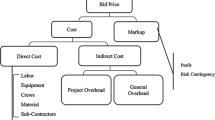Abstract
Optimum scheduling and risk prediction in high-rise building projects are among the most important factors that can determine a project’s success or failure. Non-working days due to strong wind should be accurately reflected in the initial construction planning and scheduling process, but existing methods only use the wind speed at ground level or make calculations based on the power distribution law. Thus, in this study, a method of using actual measured data via radiosonde and the Weibull distribution was proposed to calculate the non-working probability for height sections at various altitudes and predict the number of non-working days. This approach has advantages over existing methods. In particular, the Weibull distribution can be used to increase the reliability of wind speed prediction when measured data are not sufficient. Finally, the derived results using the Weibull distribution empirically showed more non-working days, which imply that potential risk due to wind speed can be reduced by the proposed method in the construction phase for high-rise buildings.
Similar content being viewed by others
References
Ford, G., Patterson, J., and Sims, B. (2009). “How to determine construction project rain delay times using local rainfall databases in asheville.” NC. Construction Research Congress 2009, pp. 380–385.
Genschel, U. and Meeker, W. Q. (2010). “A comparison of maximum likelihood and median rank regression for weibull estimation.” Quality Engineering, Vol. 22, No. 4, pp. 236–255.
Ha, Y. C., Kim, J. R., and Kim, G. S. (1998). “Basic wind speed map of korea for wind resistant design.” Journal of the Architectural Institute of Korea Structure & Construction, Vol. 14, No. 8, pp. 75–83.
Han, Y. G., Cho, K. M., Hong, T. H., and Hyun, C. T. (2012). “Percentage of worable days in scheduling superstructure work for building construction projects in Korea.” KSCE Journal of Civil Engineering, Vol. 16, No. 4, pp. 517–525.
Hwang, J. W., Yoo, K. P., and Kim, H. Y. (2010). “Comparison of wind energy density distribution using meteorological data and the weibull parameters.” Journal of the Korean Solar Energy Society, Vol. 30, No. 2, pp. 54–64.
Jung, S. N. and Lee, H. K. (2003). “A Study on the method of decision making for the optimal starting time considering the climate elements.” Journal of the Architectural Institute of Korea Structure & Construction, Vol. 19, No. 5, pp. 113–120.
Kim, S. T., Kim, Y. S., and Jin, S. Y. (2004). “Relationship between construction productivity and the weather elements.” Korean Journal of Construction Engineering and Management, Vol. 5, No. 6, pp. 80–89.
Koo, H. S. and Choi, B. C. (1999). “A study on the estimation of construction period considering weather factor in building construction.” Journal of the Architectural Institute of Korea Structure & Construction, Vol. 15, No. 11, pp. 87–96.
Lee, H. S., Shin, J. W., Park, M. S., and Ryu, H. G. (2009). “Probabilistic duration estimation model for high-rise structural work.” Journal of Construction Engineering and Management, Vol. 135, No. 12, pp. 1289–1298.
Lee, H. S., Jo, S. J., Park, M. S., Hwnag, S. J., and Kim, H. S. (2012). “A study of the work efficiency in the high altitude according to climatic elements.” Korean Journal of Construction Engineering and Management, Vol. 13, No. 3, DOI: 10.6106/KJCEM.2012.13.3.067.
Lee, K. H., Kim, K. R., and Shin, D. W. (2006). “Improvement of nonworking day estimation affected by weather conditions in the construction projects in Korea.” Korean Journal of Construction Engineering and Management, Vol. 7, No. 4, pp. 100–108.
Lee, S. S. and Kim, J. Y. (2013). “Comparative study of effects of surface roughness on wind speed in domestic and international wind code.” Journal of the Wind Engineering Institute of Korea, Vol. 17, No. 1, pp. 13–19.
Olteanu, D. A. and Freeman, L. J. (2010). “The evaluation of median rank regression and maximum likelihood estimation techniques for a two-parameter weibull distribution.” Quality Engineering, Vol. 22, No. 4, pp. 256–272.
Shin, J. H., Lee, J. A., and Lee, C. S. (2005). “The estimation of nonworking days for the construction project in incheon region.” Korean Journal of Construction Engineering and Management, Vol. 6, No. 1, pp. 58–64.
Ulrike Genschel and William Q. Meeker (2011). “A comparison of maximum likeihood and median rank regression for weibull estimation.” Quality Control and Applied Statistics, ISSN 0033-5207, Vol. 56, Nos. 1-2, pp. 115–116.
Ushiyama, Izumi. (2012). Wind Energy, Sung-an-dang, Pa-Joo.
Yoon, J. W. (2003). “The characteristics for wind in the 29 cities of Korea.” Journal of the Architectural Institute of Korea Planning & Design, Vol. 19, No. 11, pp. 229–236.
Author information
Authors and Affiliations
Corresponding author
Rights and permissions
About this article
Cite this article
Kim, S.H., Kim, YS. Non-working day estimation in high-rise building construction with wind load data by radiosonde and weibull distribution. KSCE J Civ Eng 21, 2037–2048 (2017). https://doi.org/10.1007/s12205-016-1155-4
Received:
Accepted:
Published:
Issue Date:
DOI: https://doi.org/10.1007/s12205-016-1155-4




